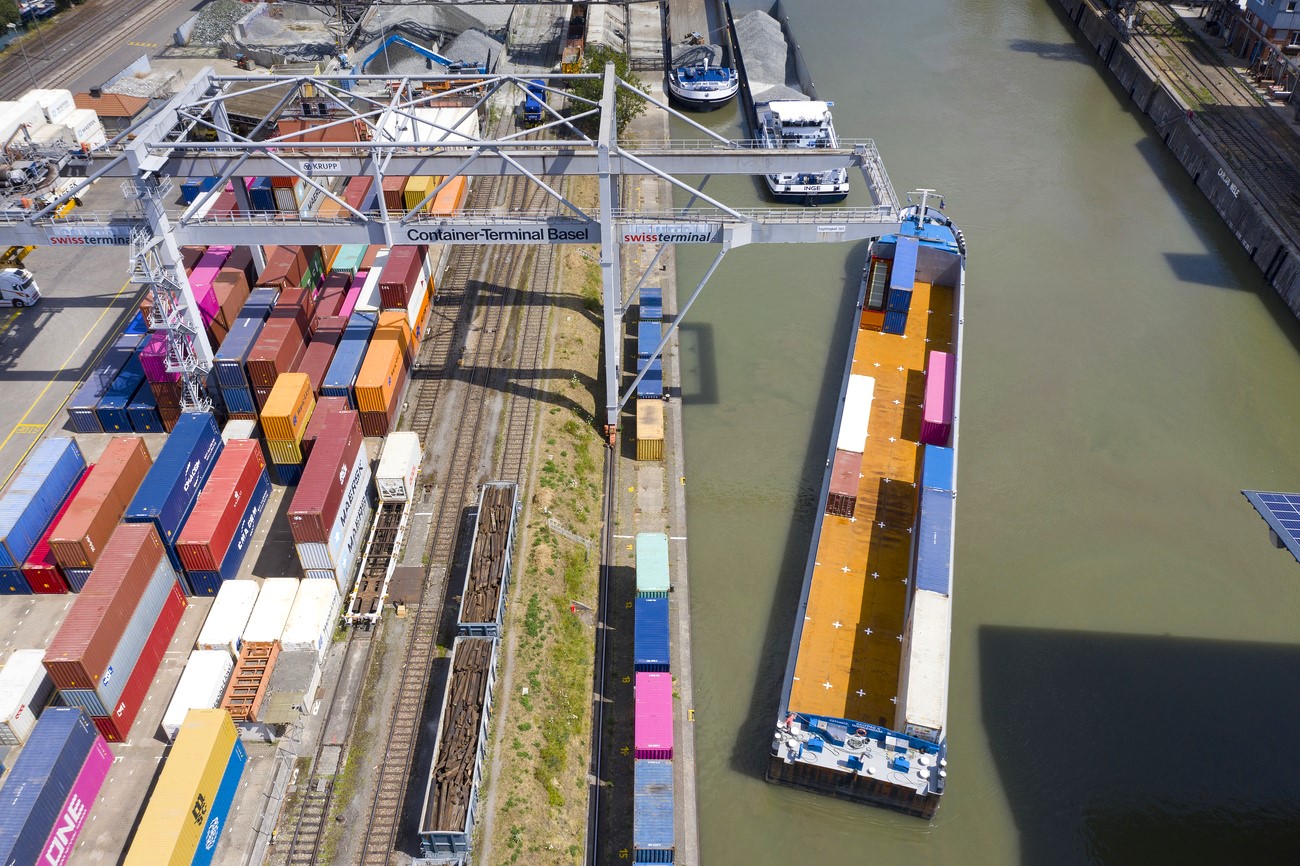Why Switzerland’s carbon footprint is bigger than you think

Is Switzerland a model carbon-reducer or a top emitter? It depends on whether you consider products imported from abroad, which make up a huge part of the country’s carbon footprint. It’s all part of a complex international give-and-take.
In Switzerland, emissions of CO2 and other greenhouse gases have fallen by almost 25% since 1990External link, bucking the trend on a global level. National climate policies and improved energy efficiency have had a positive effect. Has the Alpine country therefore succeeded in reducing its climate impact? Not exactly.
On February 9, 2025, the Swiss people will vote on the popular initiative “For Environmental Responsibility”. The young section of the Swiss Green Party’s proposal calls for the economy to take planetary limits into account: economic activities cannot use more resources or emit more pollutants than the planet can bear, according to the initiative.
The issues at stake in the popular vote and the arguments for and against are explained here.
The initiative also includes climate change targets among limits not to be exceeded. The consumption of goods and services generates CO2 emissions not only in Switzerland, but also abroad, and this has an impact on climate and the environment. This article analyses the per-capita emissions of Switzerland and other countries in the context of international trade.
Switzerland is also indirectly responsible for emissions that occur in other countries. These are the emissions associated with the production and transport of products imported and consumed by people within Swiss borders. It could be a computer assembled in China, a car manufactured in South Korea, or an avocado grown in Brazil.
These imported CO2 emissions are more than three timesExternal link higher than domestic ones – one of the highest proportions in the world. Neglecting these so-called “grey” emissions gives a distorted picture of Switzerland’s carbon footprint.
Only domestic emissions are cited during international climate negotiations and in public debates “in order to show that Switzerland is among the best in class,” says Augustin Fragnière, deputy director of the Competence Centre in Sustainability at the University of Lausanne. But accounting for import- and consumption-related emissions, “Switzerland is among the fifteen countries with the most emissions per capita in the world”.
The Swiss carbon footprint is among the highest in the world
Within the country’s borders, per-capita CO2 emissions generated by industry and the combustion of fossil fuels (3.7 tonnes in 2023) are falling and are lower than the world average of 4.6 tonnes. Fragnière says per-capita emissions are relatively low for a developed economy like Switzerland.
Other industrialised states show similar trends, although the US, Germany and Japan remain above the global average.
But if emissions generated abroad are accounted for, Switzerland’s per-capita carbon footprint is almost 14 tonnes per year, about three times the world average. The figure would be even higher if emissions generated by flights were also taken into account: the Swiss population is among those who fly most often. In Europe, only people living in Belgium and Malta have a larger carbon footprint.
In Switzerland, emissions associated with net imports (or consumption-based emissions) have increased by about 30% since 2000, according to the Global Carbon ProjectExternal link, an independent scientific organisation that was cofounded by the World Climate Programme. This progression reflects the increase in the volume of imports into Switzerland and in international trade worldwide in general. By contrast, the Federal Statistical OfficeExternal link, which uses a different calculation method, speaks of a substantially unchanged trend.
The discrepancy between territorial emissions (falling) and imported emissions (unchanged or rising) shows that the Swiss population has not substantially changed its consumption habits in the face of climate change, according to Fragnière.
80% of Switzerland’s climate footprint is due to imports
Switzerland has the highest proportion of imported emissions in its carbon footprint (almost 80%) of any country in the world. It is a high-income country and therefore consumes a lot, says Fragnière. “We have to emit a lot of CO2 abroad to manufacture the products we import and consume in Switzerland,” he explains.
Imported food, household goods and clothing mainly affect the carbon footprint of households in Switzerland, according to a studyExternal link by the Federal Office for the Environment (FOEN) published last year.
>> Who pollutes most in Switzerland? The young or the old, the rich or the poor? Find out in this article.
But Switzerland’s carbon footprint is not just about consumption habits and living standards.
The country has few natural resources, meaning it is forced to import most of its raw materials and industrial and agricultural products. The chemical and pharmaceutical industries, for example, import the most greenhouse gas emissions as an economic sector, according to a recent studyExternal link by the research and consultancy firm Ecoplan.
Switzerland’s economy is oriented around the service sector, so it has no large polluting industries such as refineries or steel mills. It also generates almost 98% of its electricity from non-CO2-emitting sources such as hydro, solar and nuclear power. The global average is just under 40%External link. This means that Switzerland’s production of goods for export, such as machinery and watches, is “cleaner” than the production of those it imports.
This affects the balance of emissions associated with trade and makes Switzerland a net importer of CO2 emissions. This is also true for almost all European countries, the United States and many African countries.
Who is responsible for imported emissions?
International climate policies and emission reduction targets under the Paris Agreement – the largest global treaty on climate change – focus exclusively on territorial emissions. No government has yet committed to reducing imported CO2 emissions. SwedenExternal link became the first country to propose a national target for such emissions in 2022 but has not yet formally adopted it.
Katarina Axelsonn from the Stockholm Environment Institute (SEI), a Swedish research institute dedicated to sustainable development and the environment, co-authored a studyExternal link on measures to reduce imported emissions worldwide. She argues that responsibility must be shared between both parties.
“Businesses in producing countries, like China, must adopt sustainable practices to reduce emissions linked to manufacturing. At the same time, importing countries like Switzerland and their consumers need to be mindful of their consumption patterns,” Axelsonn told SWI swissinfo.ch.
The SEI study recommends, for example, binding European targets for consumption-based emissions and support for developing countries to adopt sustainable production practices.
CO2 tax on polluting products imported into the EU
A CO2 tax on imported products, such as the one introduced by the European Union in 2023, can encourage consumption with a lower carbon footprint, believes Elisabetta CornagoExternal link, researcher at the British think tank Centre for European Reform.
The carbon border adjustment mechanism (CBAM) currently imposes a tax on certain carbon-intensive products imported into the EU, including steel, cement and fertilizers. “It is still early to see effects on trade flows, but we see that the CBAM has already encouraged several non-EU countries to adopt policies that impose a price on carbon, such as the creation of emissions trading schemes,” says Cornago, citing the examples of Turkey, Brazil and India.
Switzerland is not a member of the EU and has so far not adopted the European CO2 tax system. In 2023, the government recommended against its introduction. However, a parliamentary initiativeExternal link, not yet treated by the chambers, calls for the creation of the basis for a CO2 adjustment mechanism at the Swiss border.
According to the Federal Office for the Environment, Switzerland already has instruments to counter imported emissions. The new federal climate law in force since the beginning of 2025, for example, provides for financial aid to companies that adopt innovative technologies and processes to reduce their direct and indirect emissions.
For Fragnière, the most effective solution remains to consume less or consume better, for example by favouring products that have less impact on the climate during the manufacturing process.
Consuming more sustainable products, avoiding or reusing them where possible, can help reduce unnecessary pressure on planetary resources, echoes Axelsonn.
“Ultimately, this is a shared responsibility that requires collaboration across borders to achieve a real and lasting impact,” she notes.
Edited by Sabrina Weiss and Veronica DeVore/ds

More
Newsletters

In compliance with the JTI standards
More: SWI swissinfo.ch certified by the Journalism Trust Initiative














You can find an overview of ongoing debates with our journalists here . Please join us!
If you want to start a conversation about a topic raised in this article or want to report factual errors, email us at english@swissinfo.ch.